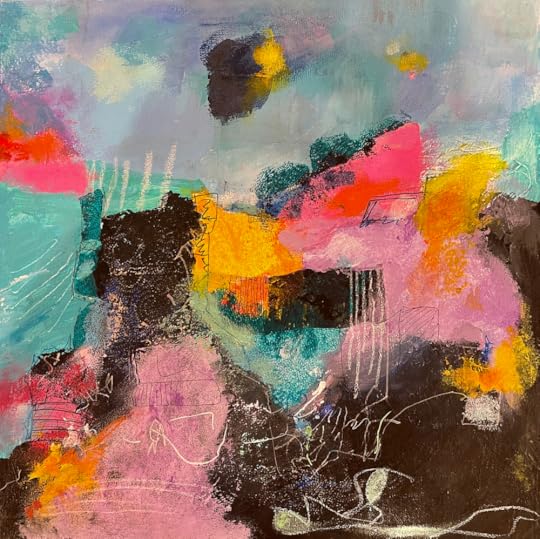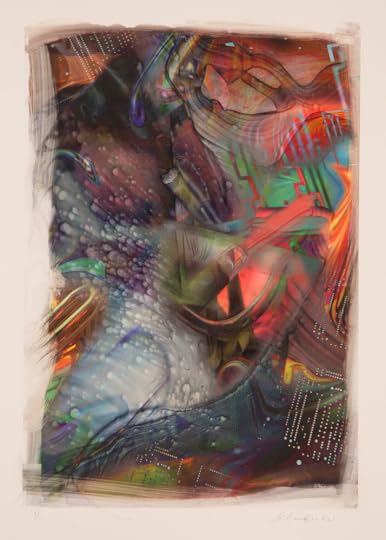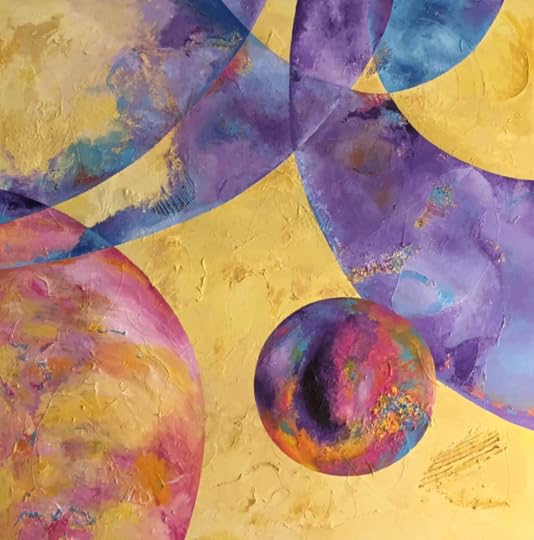Evan Stuart Marshall's Blog: MARSHALL ARTS
August 31, 2025
Arrowheads, Fossils, and Forgotten Stories — The Mystery of Archaeology Art
April 29, 2025
How to Talk About the Art You Collect (Even If You're Not an Expert)
Should You Work in a Series? Why It Might Be the Key to Stronger Art (and Sales)
April 15, 2025
Art Off the Wall: Creative Ways to Display Art
7 Smart Ways to Save Money on Art Supplies (Without Compromising Your Art)
April 2, 2025
Spring Cleaning Your Art Practice
March 18, 2025
Artist Spotlight: Karen LaGreca
March 6, 2025
The Evolution of Abstract Art: From Early 20th Century to Today
Abstract art is all about energy, emotion, and personal interpretation. Since the early 1900s, artists have pushed boundaries, moving away from realism to explore pure color, shape, and movement. Today, artists continue that tradition, using bold colors, layered textures, and unexpected compositions to connect with viewers in a personal way.
In the early 1900s, artists like Wassily Kandinsky, Kazimir Malevich, Hilma af Klint, and Sonia Delaunay stepped away from painting recognizable subjects. Kandinsky believed colors and shapes could express emotions. Malevich stripped things down to simple geometric forms. Hilma af Klint created spiritually inspired works before abstraction was even recognized as a movement. Delaunay blended abstraction with design and fashion, using bold colors and dynamic shapes.
By the mid-20th century, abstraction took another leap. Artists like Jackson Pollock, Mark Rothko, Willem de Kooning, Joan Mitchell, and Lee Krasner brought intense energy to their work. Pollock dripped paint in wild, unpredictable ways. Rothko’s color fields created deep, meditative spaces. De Kooning’s bold brushstrokes captured raw emotion. Mitchell and Krasner made powerful, expressive marks that proved abstraction was limitless.
Today’s abstract artists build on these traditions while adding their own spin. Many modern pieces still use bold colors, energetic mark-making, and layered textures. My painting Electric Dreamscape (shown below) is one example. Deep blacks contrast with vibrant pinks, while loose, organic marks add energy. The layered textures invite closer inspection, much like the works of past Abstract Expressionists.

Electric Dreamscape, mixed media on gallery wrapped canvas, 20" x 20" x 1.5"
Abstract art is open to interpretation. It doesn’t tell a specific story. Instead, it invites viewers to find their own meaning. It can set a mood, add energy to a space, or simply be something beautiful to look at.
It’s also a strong choice for collectors. Abstraction has been around for over a century and continues to evolve. It fits into many styles—whether your space is modern, eclectic, or somewhere in between. A great abstract piece can bring everything together. And a knowledge of the evolution of the abstract art movements gives additional meaning, a context, to the pieces you add to your collection.
If you love the movement and emotion of Abstract Expressionism or the clean lines of geometric abstraction, today’s artists are keeping those ideas alive in fresh ways. Collecting abstract art isn’t just about buying a painting. It’s about bringing something dynamic, thought-provoking, and deeply personal into your space.
Want to explore abstract art further? Check out available works or reach out to find the perfect piece for your collection. I am always happy to work with collectors to find the perfect piece.
February 21, 2025
Artist Spotlight: Sarah Canfield

Sarah Canfield is an artist known for merging painting and digital photography to create works in multiple media that cross boundaries between photorealism and abstraction. Her paintings, collages, mixed media works, and wall hung sculptures have been exhibited in venues including the Montclair Art Museum, the Morris Museum, the Visual Arts Center of New Jersey, the Pennsylvania State Museum, and the Woodmere Art Museum. Canfield holds a BFA in painting, cum laude, from Alfred University. She is an instructor at the Montclair Art Museum and Union College in New Jersey. She has given guest lectures at Newark Academy, Caldwell University, and Pratt Institute and is the recipient of a 2022 Fellowship in Painting from the New Jersey State Council on the Arts. Her art has been featured in the Quiet Lunch, ANTE Curatorial, and Art Spiel art blogs, as well as The Philadelphia Inquirer and The New York Times. She has a studio in Manufacturers Village in East Orange, New Jersey.
Can you describe your art in one sentence?
I create hybrid, futuristic environments that reverberate between reality and illusion.

Regeneration, pastel on paper, 30" x 47"
What inspired you to start creating art?
Creating art has been a way for me to see and understand the world around me. Sharing my work connects me with others in a meaningful way.
What’s your creative process like?
I merge abstract painting and photography techniques to create works in painting, pastel, mixed media, collage, and wall hung sculpture. I toggle back and forth between working with traditional art media in the studio and using digital photography and manipulation on the computer.
What’s one piece of advice you’d give to emerging artists?
Create art as consistently as possible and stick with it. Expect that it will not always be easy. Continuity allows a deeper connection with the work over time and it will grow and evolve along with you.
Where can people see your work and follow you?
I have a solo exhibition currently on view at the Brassworks Gallery, 105 Grove Street in Montclair through April 25th. Hours are 7AM-7PM M-F, or by appointment (email me at sarah.canfield@gmail.com)
Instagram: @sarahcanfieldart
Sarah Canfield
www.instagram.com/sarahcanfieldart/

February 20, 2025
Creating a Focal Point: How to Style a Room Around a Statement Painting
When decorating a room, nothing commands attention quite like a bold statement painting. Whether you’re looking to revitalize your living space or add a touch of sophistication to your office, a striking piece of abstract art can serve as the perfect focal point. But how do you style a room around such a powerful visual element without overwhelming the space? Here’s how to make it work seamlessly.
The key to creating a cohesive look is to treat your statement painting as the anchor of the room. Everything else—furniture, rugs, lighting, and accessories—should complement, not compete with, the artwork. Begin by examining the dominant colors in the painting. Are they bold and vibrant, or soft and muted? Use these hues as a guide to select complementary or contrasting accents throughout the room.
For example, if your painting features vivid blues and rich golds, consider incorporating these colors into your throw pillows or area rug. However, don’t go overboard. Choose two or three key colors to repeat subtly throughout the space for a polished, harmonious look.
We Are Not Alone – Acrylic on Canvas, 36" x 36" x 2"

I designed this painting so that its swirling shapes and vibrant colors would create a sense of movement and intrigue, making it a natural focal point for any room. Its dynamic composition is intended to add energy to contemporary living spaces or home offices. For a balanced look, pair it with neutral furnishings and minimalistic decor.
See More Details – Discover how this painting could enhance your space.
Placement is everything. A statement painting deserves a prime spot where it can truly shine. Above the sofa, over the fireplace, or as the centerpiece in a dining room are all excellent choices. When hanging your art, aim to position the center of the painting at eye level, which is typically about 57 to 60 inches from the floor. This keeps the painting at a comfortable viewing height and makes it the natural focal point.
If you’re placing the painting above a piece of furniture, such as a sofa or console table, make sure to leave about 6 to 12 inches of space between the top of the furniture and the bottom of the frame. This keeps the elements visually connected without feeling cramped.
Consider using a gallery wall approach if you have multiple smaller pieces. Group them closely together, maintaining a uniform spacing of about 2 to 3 inches between frames, to create a cohesive and intentional display.
A bold painting can quickly overwhelm a space if it’s surrounded by other vibrant elements. To keep the look balanced, opt for neutral furniture and accessories that won’t compete for attention. White, gray, beige, or muted earth tones provide a calm backdrop that lets the artwork take center stage.
For instance, if your statement painting features dynamic brushstrokes and vivid colors, pair it with a neutral sofa and understated coffee table. This contrast enhances the painting’s visual impact without creating visual chaos.
Fields of Color – Oil and Cold Wax on Panel, 20" x 20" x 1.5"

With its mix of vibrant blues, pinks, and greens, Fields of Color was created to add a lively touch to any room. I used this abstract grid-like design to create a sense of playfulness, making it a great choice for home offices or modern dining areas. Style it with minimalist furniture to allow the colors to stand out without overwhelming the space.
See More Details – Learn how this painting can brighten up your space.
To create a sense of unity, subtly echo the shapes and lines from your painting in the room’s decor. For example, if your abstract art features sweeping curves, consider choosing a round coffee table or curvy armchairs. Conversely, if the painting is more angular and geometric, opt for furniture with clean lines and sharp edges.
This repetition of form helps to establish a cohesive visual flow, subtly tying the room together without being overly matchy-matchy.
Specters of Salem – Mixed Media on Canvas, 20" x 20" x 1.5"

In Specters of Salem, I tried to capture a narrative quality that invites curiosity and reflection. I feel that its storytelling elements and rich palette make it an ideal conversation starter in a library, hallway, or eclectic living room. It pairs well with vintage furniture and muted tones for a more contemplative ambiance.
See More Details – Discover how this piece could be a conversation starter in your home.
Proper lighting is crucial for showcasing your statement painting. If possible, position your art in an area with plenty of natural light, but be mindful of direct sunlight, which can cause fading. Complement natural light with strategically placed accent lighting, such as track lights or picture lights, to highlight the texture and colors of the painting.
For a dramatic effect, consider installing adjustable wall sconces or ceiling-mounted spotlights. The right lighting not only enhances the artwork but also adds depth and dimension to the entire room.
Your decorating style plays a role in how you style a room around a statement painting. For a minimalist look, keep furniture and accessories to a minimum, allowing the artwork to be the undeniable star. Choose sleek, understated pieces and maintain an uncluttered space to amplify the painting’s impact.
On the other hand, if you prefer a maximalist approach, feel free to layer bold rugs, textured cushions, and curated collections of objects. The trick is to ensure that the colors and patterns complement the artwork without overshadowing it. Mixing textures—like pairing a smooth canvas with plush velvet or rough-hewn wood—adds richness and depth.
A statement painting does more than fill a wall; it sets the tone and mood for the entire room. It’s a conversation starter, a reflection of your personal style, and a dynamic way to transform your space. By thoughtfully designing the room around the artwork, you can create a harmonious and visually stunning environment that feels both curated and uniquely yours.
Looking to transform your space with a bold, vibrant piece of abstract art? Discover my collection of original paintings designed to inspire and elevate any room. From dynamic brushstrokes to vivid color palettes, each piece is crafted to become the centerpiece of your space.
Browse my latest works here and find the perfect statement painting to enhance your home or office. If you need help choosing the right piece, feel free to contact me for personalized recommendations.
Subscribe to my newsletter for the latest updates on new releases, behind-the-scenes glimpses into my creative process, and styling tips for incorporating abstract art into your home.
MARSHALL ARTS
- Evan Stuart Marshall's profile
- 1 follower



